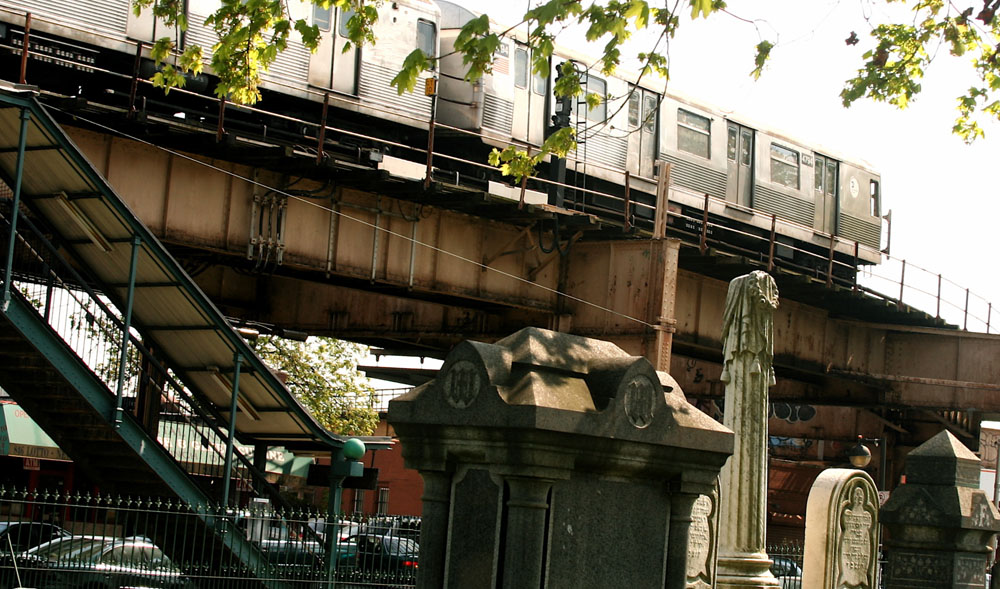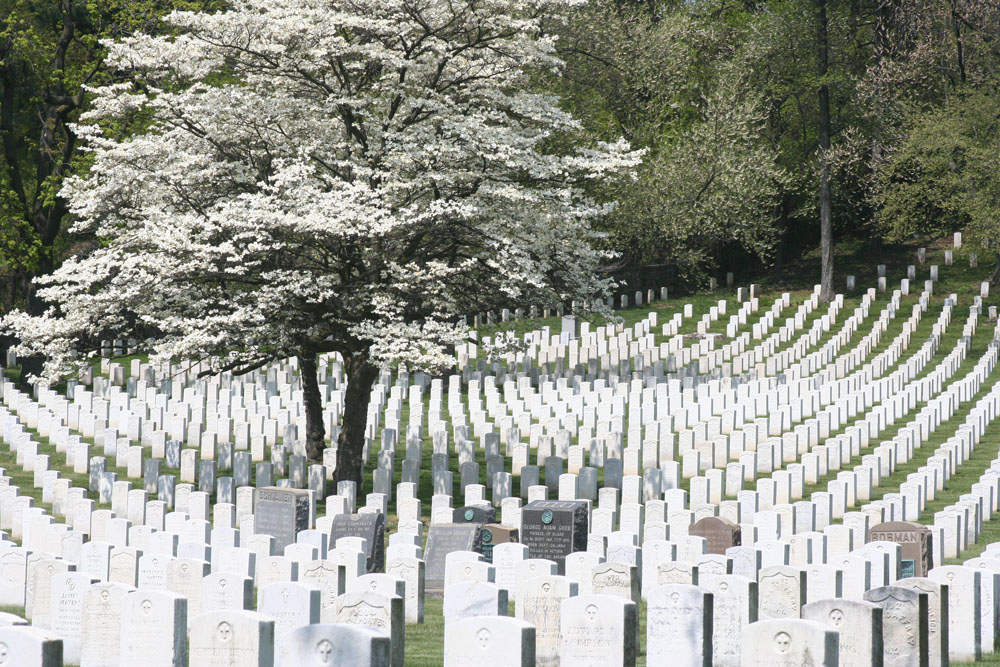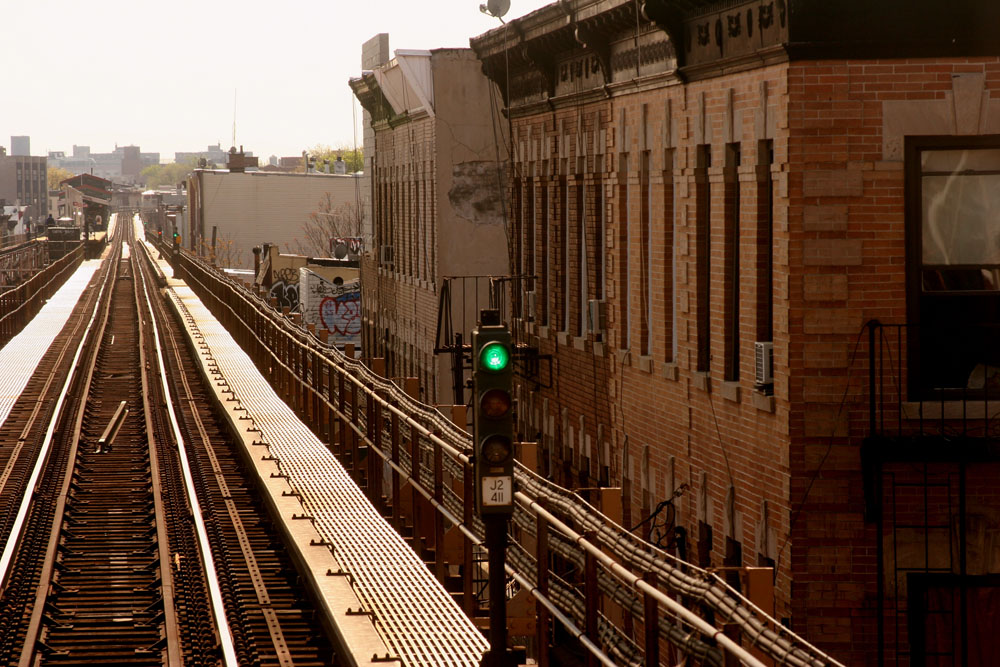Cypress Hills, J Train
Turning an elevated corner, in the crook of which stands a decaying apartment, shades drawn to half-mast, darkness inside where life is shared with a world not paying attention, our writer does light research.
The Cypress Hills station straddles Jamaica Avenue along two southern blocks of the vast acreage of the dead that is the northeastern corner of Brooklyn where it folds into Long Island. From the Manhattan-bound platform, a visitor could drop stealthily into the neglected public front plots of Salem Field, or gaze, uninvited, into the less-accessible private plots of Shearith Israel, guarded by a massive portico.
Visitors to Shearith Israel are called out to through a beleaguered screen in the whitewashed wall and instructed to stop at the office first. In the office, a woman looks up from her lunch to ask a visitor which particular grave is sought. Absent a concrete answer, the visitor is informed, unapologetically, that there is no “wandering” in this cemetery.
The neighboring Cypress Hills National Cemetery, on the other hand, has gates thrown wide. Seven thousand simple white headstones create the usual optic disturbance, arrayed about 400 yards back from the avenue and halfway up the first of Cypress Hills.

At the slope’s summit stand a few scattered markers—the peanut gallery in a theater of the dead. (The veteran’s department prefers the term “bivouac of the dead.”) Here lie veterans George Washington Scherer, Harry Anton Heitman, Cornelius McGrath, Vito Amato, and Wing Wong. Here also lies Jean, wife of PFC J. Scoca, and some infant sons and daughters.
Sergeant Daniel Joseph Daly, one of just two American marines to receive the Medal of Honor twice, was buried in Cypress Hills National Cemetery in 1937.
Daly earned his initial medal during the Boxer Rebellion for exhibiting meritorious conduct during the battle for Peking. He fought members of a secret peasant organization originating in the northern Shandong Province, self-avowed sorcerer warriors calling themselves The Fists of Righteous Harmony.
Starving but fiercely trained in martial arts, the peasant army fought both to topple the oppressive Chi’ng Dynasty and to give all foreigners the boot. They succeeded only in the former, when the Empress Dowager Tsu His hustled out of the Forbidden City in February 1900 in the back of a cart, ahead of a clamorous hoard of 20,000 rebels.
It’s possible he let down his guard on occasion. Perhaps there was the spell of spilled blood and feathers to the Haitian gods, and a momentary thought for campaigns non-martial.
Shortly thereafter, the Boxers (termed as such by Westerners who admired but knew nothing of the martial arts they faced) were overrun by the Artillery of International Relief, a force quickly established by concerned diplomats worldwide, and among whose numbers was Dan Daley. The Boxers were routed, their long-awaited “spirit soldiers” having failed to rise from the dead and come to the aid in the defense of China.
Fifteen years later, America looked around and found another species of Boxer—Haiti’s rebels wore a red armbands, and were known therefore as Cacos, after the red-plumed bird of the highlands. When their successful revolt ushered in another wave of anarchy, U.S. forces arrived to control “foreign interests.”
It was during a battle against 400 Cacos that Daly fought “with exceptional gallantry and against heavy odds” and won himself a second medal. The Cacos, meanwhile, fought with their backs to the seawall, finding at the bitter end nowhere to retreat. They were stormed in their own fortress at Fort Reviere and the back of the force of ex-slaves was broken.
Dan Daley was a five-and-a-half foot, 135-pound bachelor from Glen Cove, N.Y. The only other double Medal of Honor recipient, General Smedley Butler, called his contemporary Daly “the fightinist marine I ever knew.” It’s possible he let down his guard on occasion. Perhaps during his vigil there were opium dens. Perhaps there was the spell of spilled blood and feathers to the Haitian gods, and a momentary thought for campaigns non-martial. Dan Daley capped off his illustrious military career with 17 years of service as a security guard at a bank on Wall Street.

Before 1873, when burial rights were extended to honorably discharged soldiers, sailors, and marines, the Cypress Hill National Cemetery grounds were reserved for the Civil War dead. More than 3,000 Union soldiers and close to 500 Confederate prisoners rest there. Five hundred unknown soldiers are buried with markers under flowering trees.
Only one cypress grows in the Cypress Hill National Cemetery, not far from an enormous weeping something that, in stark contrast to the redbuds and cherry trees nearby, regularly fails to come out on the other side of winter.
A few blocks south, a fifth-grade teacher in the Little Red School House, built in 1897, begins his lesson on the American Revolution.
“Shhhhh,” he hushes them. “Quieter. Do you hear it?” he asks. “Do you hear them?” he specifies. “Not the kids outside,” he clarifies. “The cannon. The drums. Do you hear the marching boots?”
Standing water two feet high measured the strange declivity that for decades went unnoticed by theater-goers, probably due to the vertiginous effect of walking in darkness toward an image six times life-size.
Some of the pupils shake their heads no, but the undaunted teacher announces, “Because if you had been sitting here in 1776, that’s what you’d have heard, and you would have seen soldiers rushing past and smoke everywhere and the revolutionary forces swarming over Cypress Hill.”
If, on the other hand, these children had been alive in 1976, to climb to the schoolhouse roof and survey the neighborhood, the smoke rising from the corner of Fulton and Richmond Roads they would have seen would have come from the demolition of the Embassy Theater.
Razed to make room for a home for the aged, the Embassy joined in rubble the smaller-by-a-third Gem Theater, a single-screen cinema knocked down in 1955, together with the photography studios of Julius Berzinsky and a German deli run by a man named Brenner, to allow the neighboring bank to expand.
Before its demolition, the Gem stood empty for a period of months, during which occurred several strong rainstorms. When surveyors arrived ahead of the wrecking crews, they entered at street level, but because the theater was built on an incline, they found the entire eastern half of the stage and orchestra pit flooded. Standing water two feet high measured the strange declivity that for decades went unnoticed by theater-goers, probably due to the vertiginous effect of walking in darkness toward an image six times life-size.

Prior to the Gem, a silent theater stood on the site but burned down in the mid-’30s. Other bygone attractions along Fulton Road included Hale Bowling, Cordes Ice Cream Parlor, and a hunchback man selling enormous balloons who stood at the corner of Fulton and Highland Place.
Today, they are replaced with shuttered storefronts, Dominican restaurants, nail salons, and a poultry factory. In a cardboard box just outside a junk shop lie a pile of weathered children’s books. Inside a copy of Johnny Tremain is a bookmark listing the weekly schedule for the Gem Theater. From February 23 to March 2, 1950, the cinema screened six pictures, including Quicksand, starring Mickey Rooney, Peter Lorre, and Jeanne Cagney. Friday and Saturday matinees featured Atom Man vs. Superman.
That same week, Private First Class George Fudenski was buried in Cypress Hills National Cemetery. At age 105, he was one of the last Civil War veterans to be laid to rest there, in a plot far from the rattley-bang of the eastbound J train heading toward Jamaica along New York’s oldest elevated train line, which still parallels the third-story lives of furthest-flung Brooklyn—its half-blinded bedrooms and window-sill plants and sinks full of dishes just an arm’s length from your transiting self.
